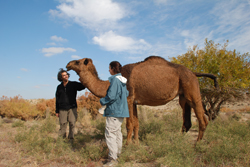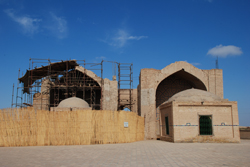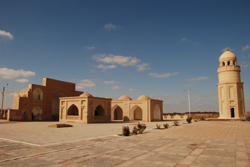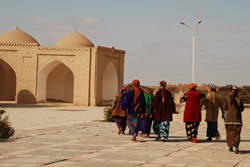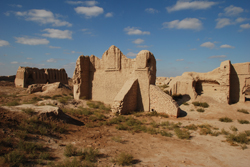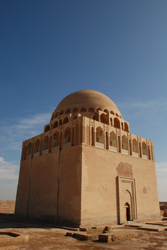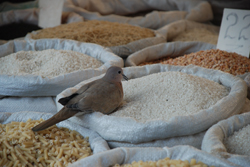Welcome to Iran
2 November, 2008, 02:02 am in "Iran"
Rowshan couldn't wait to get to Iran. It took us about 4 hours to get to to the border. We got a car quick enough but about ½ hour out of Mary it started having problems so the driver turned back. Then it broke down completely. We got picked up by another car but it made a stop in a different town and took a longer route to Sarakhs because the shorter road was supposedly really bad.
The Turkmen border crew went to lunch when we arrived. I think that is just what they do when they see someone besides the standard truck drivers. Fortunately their lunch break wasn't long and soon the customs official, who resembled a pig, arrived. He sat down to fill out our customs forms. Then I noticed something odd. He kept raising his eyebrows suggestively at Rowshan. At first I thought he had made a joke that I missed. However, when Rowshan, who is always one to appreciate jokes, didn't respond, I thought maybe the official was flirting with him. After all, if a guy was making those kinds of looks at a woman, it would definitely be flirting. As he handed Rowshan the customs form, he whispered something in his ear. Eventually he searched our bags, making more meaningful glances at Rowshan. Rowshan who was getting annoyed, told him, "Could you be quicker, we need to leave." So the official finally finished filling out the forms and sent Rowshan to get the forms stamped by another official (who amazingly was there!).
Then we had to wait for the passport stamping official who had disappeared when he saw we were about ready for our passports to be stamped. As we waited, Rowshan complained, “They all want bribes! Did you see that official?” “Oh!” I said, “That's what he meant?”
We managed to get through the border bribe free and had to board a minivan for a 1km trip across no-man's land. A guard pointed to a minivan but the driver wasn't in sight. Then he opened the door and revealed the driver sleeping in the back. The charge was 20,000 manat (less than $2). We didn't have any manat left so the driver said we could pay $3 instead. “Why can't we just walk?” I asked. “The guards won't permit it,” the driver said. Rowshan went to ask the guards and they said they would permit us to walk if we paid 30,000 manat. Grudgingly we took the vehicle.
During the short ride, Rowshan let out a torrent of abuse against Turkmenistan: the numerous checks where everyone writes down the same info, the attempts at getting bribes, the bureaucracy left over from the Soviet Union... He eagerly anticipated our arrival in Iran where they were above that sort of thing-- an advanced country. Iran was just across the bridge but we had to stop for another passport check where once again they needed to register our passports. Once again the officer wasn't there. Supposedly he had gone to use the bathroom though the driver said he was probably having lunch. He came back, looked at our passports, got confused and then allowed us to clear things up. Finally he finished but we still couldn't cross the bridge because the one lane bridge was full of trucks. Instead of having the trucks park off the bridge, the guards stopped them on the bridge to check their papers. Rowshan fumed some more against Turkmenistan. The driver of the minivan tried to calm him saying, “Don't be mad at me. It takes 5 fingers to make a hand-- people are all different: one is a cow, one is a donkey, one is a good person.” Finally the guards gestured for the last truck to drive off the bridge and park there so we were able to cross. We had reached Iran. A guard immediately took our passports and sent us to the custom's building. Rowshan paid the driver his requested $3 but he returned $1. Rowshan told him “You are a good person,” and we left on good terms.
Rowshan excitedly pointed out how the waiting room had chairs, there was a toilet, rooms for praying, tidy offices, and a doctor on hand. The building was clean and looked newly painted. We used the bathrooms which had liquid soap at the sink and both hot and cold water. Then we waited for our passports... and waited.... and waited.... Finally Rowshan found out they were confused about how we left Iran since we got new Iranian passports in the US by mail. So we had to provide our US passports. This worried me because I had no idea what Iran's take on dual citizenship is. I waited nervously. Rowshan returned to the window. I saw them laughing so they must have been joking about something. Finally we got our passports and were sent to customs. The guard told us not to show customs the US passports. At customs they told us to empty our two backpacks. Most countries, if they check, use an x-ray machine. Rowshan emptied his pack first pulling out his stuff. I started pulling out my clothing, neatly folding them. The customs guy made Rowshan unwrap all his ceramics and show what was on them. He also tweaked one checking that it wasn't hollow. He said he had to check that they were no political logos or images of scantily clad women on them.
Finally we got through the border. It had been one of the longest border crossings we'd experienced on our trip. Rowshan was still happy about being in Iran. He raved about the existence of a taxi company and set prices. The ride to Mashad revealed a landscape a bit more varied than Turkmenistan: small mountains, some Arizona like cliffs, picturesque villages with mud houses-- a relief from the repetitive desert we'd seen all through Turkmenistan and on our last couple rides through Uzbekistan. The other passengers in the cab promptly went to sleep. Rowshan raved how they went to sleep instead of asking if we were married, had kids and why not?
Arriving in Mashad after being in Central Asia felt like arriving in the middle of a holiday carnival. It was craziness: cars everywhere, colored lights, store windows filled with jars of red safron, gold sugar and candy. The streets were full of people and though the clothing was sombre, there was a festive feeling in the area.
We found a place selling soup from vegetables, beans, noodles and greens. We had to buy bread elsewhere. There was a huge line but if you were just getting one piece, you could wait in a shorter express line. There were lines for women and lines for men. The bread was baked in an oven on hot pebbles below and the flat loaves were pulled out and tossed onto a raised area for the bread man to distribute. Some, he'd hang on the wall on nails. Others he'd lie flat on a counter and pick out the pebbles that had gotten stuck in the bread. Eventually we got our hot bread and went and ate our soup along with banana milkshakes, rejoicing about the tasty meat-free meal.
The Turkmen border crew went to lunch when we arrived. I think that is just what they do when they see someone besides the standard truck drivers. Fortunately their lunch break wasn't long and soon the customs official, who resembled a pig, arrived. He sat down to fill out our customs forms. Then I noticed something odd. He kept raising his eyebrows suggestively at Rowshan. At first I thought he had made a joke that I missed. However, when Rowshan, who is always one to appreciate jokes, didn't respond, I thought maybe the official was flirting with him. After all, if a guy was making those kinds of looks at a woman, it would definitely be flirting. As he handed Rowshan the customs form, he whispered something in his ear. Eventually he searched our bags, making more meaningful glances at Rowshan. Rowshan who was getting annoyed, told him, "Could you be quicker, we need to leave." So the official finally finished filling out the forms and sent Rowshan to get the forms stamped by another official (who amazingly was there!).
Then we had to wait for the passport stamping official who had disappeared when he saw we were about ready for our passports to be stamped. As we waited, Rowshan complained, “They all want bribes! Did you see that official?” “Oh!” I said, “That's what he meant?”
We managed to get through the border bribe free and had to board a minivan for a 1km trip across no-man's land. A guard pointed to a minivan but the driver wasn't in sight. Then he opened the door and revealed the driver sleeping in the back. The charge was 20,000 manat (less than $2). We didn't have any manat left so the driver said we could pay $3 instead. “Why can't we just walk?” I asked. “The guards won't permit it,” the driver said. Rowshan went to ask the guards and they said they would permit us to walk if we paid 30,000 manat. Grudgingly we took the vehicle.
During the short ride, Rowshan let out a torrent of abuse against Turkmenistan: the numerous checks where everyone writes down the same info, the attempts at getting bribes, the bureaucracy left over from the Soviet Union... He eagerly anticipated our arrival in Iran where they were above that sort of thing-- an advanced country. Iran was just across the bridge but we had to stop for another passport check where once again they needed to register our passports. Once again the officer wasn't there. Supposedly he had gone to use the bathroom though the driver said he was probably having lunch. He came back, looked at our passports, got confused and then allowed us to clear things up. Finally he finished but we still couldn't cross the bridge because the one lane bridge was full of trucks. Instead of having the trucks park off the bridge, the guards stopped them on the bridge to check their papers. Rowshan fumed some more against Turkmenistan. The driver of the minivan tried to calm him saying, “Don't be mad at me. It takes 5 fingers to make a hand-- people are all different: one is a cow, one is a donkey, one is a good person.” Finally the guards gestured for the last truck to drive off the bridge and park there so we were able to cross. We had reached Iran. A guard immediately took our passports and sent us to the custom's building. Rowshan paid the driver his requested $3 but he returned $1. Rowshan told him “You are a good person,” and we left on good terms.
Rowshan excitedly pointed out how the waiting room had chairs, there was a toilet, rooms for praying, tidy offices, and a doctor on hand. The building was clean and looked newly painted. We used the bathrooms which had liquid soap at the sink and both hot and cold water. Then we waited for our passports... and waited.... and waited.... Finally Rowshan found out they were confused about how we left Iran since we got new Iranian passports in the US by mail. So we had to provide our US passports. This worried me because I had no idea what Iran's take on dual citizenship is. I waited nervously. Rowshan returned to the window. I saw them laughing so they must have been joking about something. Finally we got our passports and were sent to customs. The guard told us not to show customs the US passports. At customs they told us to empty our two backpacks. Most countries, if they check, use an x-ray machine. Rowshan emptied his pack first pulling out his stuff. I started pulling out my clothing, neatly folding them. The customs guy made Rowshan unwrap all his ceramics and show what was on them. He also tweaked one checking that it wasn't hollow. He said he had to check that they were no political logos or images of scantily clad women on them.
Finally we got through the border. It had been one of the longest border crossings we'd experienced on our trip. Rowshan was still happy about being in Iran. He raved about the existence of a taxi company and set prices. The ride to Mashad revealed a landscape a bit more varied than Turkmenistan: small mountains, some Arizona like cliffs, picturesque villages with mud houses-- a relief from the repetitive desert we'd seen all through Turkmenistan and on our last couple rides through Uzbekistan. The other passengers in the cab promptly went to sleep. Rowshan raved how they went to sleep instead of asking if we were married, had kids and why not?
Arriving in Mashad after being in Central Asia felt like arriving in the middle of a holiday carnival. It was craziness: cars everywhere, colored lights, store windows filled with jars of red safron, gold sugar and candy. The streets were full of people and though the clothing was sombre, there was a festive feeling in the area.
We found a place selling soup from vegetables, beans, noodles and greens. We had to buy bread elsewhere. There was a huge line but if you were just getting one piece, you could wait in a shorter express line. There were lines for women and lines for men. The bread was baked in an oven on hot pebbles below and the flat loaves were pulled out and tossed onto a raised area for the bread man to distribute. Some, he'd hang on the wall on nails. Others he'd lie flat on a counter and pick out the pebbles that had gotten stuck in the bread. Eventually we got our hot bread and went and ate our soup along with banana milkshakes, rejoicing about the tasty meat-free meal.
The Ancient City of Merv
1 November, 2008, 03:52 am in "Turkmenistan"
I had a fear that the ruins of the ancient city of Merv would be no more than piles of mud. After all, mud was the common building material of the area and didn't seem to hold up well under centuries of weather. I prepared myself for an unimpressive expanse of melted mud lump remains of walls.
So, I was pleasantly surprised when the mud walls of the Abdullah Khan Fortress, the first site we passed of Merv, had some rounded towers intact within its rather sizable melting mud walls. As we drove to the entrance of the ruins complex, I could see some actual buildings.
After a brief stop for buying tickets and glancing at the museum, we drove to the Kiz Kalas, which were built in the 6th and 7th centuries. They were made from adobe bricks and many walls were still intact as well as some arches and stairways. The walls on the exterior were made up of brick pillars set together which gave it a corrugated look. From the distance they looked like giant organ pipes. I wonder if this wall design helped shield the walls from the elements and preserve them. Through holes in the walls we could see fields with herds of camels grazing.
The area around Merv is dry with prickly plant life. But the colors are soft varigated shades of green, gold and red. The remaining structures are creamy beige—most adobe brick buildings some with brick domes coated with mud. At the smaller fortress, a family of shepherds quickly lit a fire. The women here wear long skirts that are tighter fitting than in other parts of Central Asia-- more closer to the style I like. They had long colorful scarves wrapped around their heads.
From the Kalas' we visited the mausoleums of the two Askhabs (friends of the Prophet). One of the mausoleums was completely under scaffolding but the other was visible. In front of them was a cistern with undrinkable water inside and the remains of some plaster floral designs at the entrance.
Beyond these we came upon a herd of grazing camels. It occurred to me camels faces are kind of like flamingos. Their expression has that same drooping somewhat comical upside down look.
Merv is an extremely spread out site. The road winds in and out of mud walls of ancient fortresses. In some places the ground is littered with pottery shards. The remains date from the 6th Century BC through the present restorations and re-buildings.
As Merv fell and was rebuilt, the location was changed to follow the changes in the river. So, unlike other ancient cities where the new cities was built on the remains of the old, the new was built in a different location next to the old one which was abandoned.
The Mosque of Yusuf Hamadani seemed mostly new but I guess he was a figure from the 12th century. We climbed an ornate minaret and saw people walking to an area behind the tomb and crawling under a blanket (or something that looked like a blanket... maybe it was a robe.) From there we visited the Shahriyar Ark which had some more pipe organ walls.
As Merv fell and was rebuilt, the location was changed to follow the changes in the river. So, unlike other ancient cities where the new cities was built on the remains of the old, the new was built in a different location next to the old one which was abandoned.
The Mosque of Yusuf Hamadani seemed mostly new but I guess he was a figure from the 12th century. We climbed an ornate minaret and saw people walking to an area behind the tomb and crawling under a blanket (or something that looked like a blanket... maybe it was a robe.) From there we visited the Shahriyar Ark which had some more pipe organ walls.
The most impressive structure in the area is the Mausoleum of Sultan Sanjar. It had been restored in 2002-03 by Turkey. It is a Selcuk building and towers above everything. Perhaps it is even taller than most of the historic buildings we've seen in Central Asia. It is crowned by a huge dome. The building is a simple block shape but has an ornate terraced area near the top with arches decorated with ganch designs and wood grated frames. Inside there was a splendid echo which transformed every sound into a flurry of noise-- a quiet roar.
From there we stopped by the Mausoleum of Mohammad Ibn Zeid, a 12th century buiding with modern restoration. I was walking around it when I ran into an old man with a traditional Turkmen robe and hat. He informed me I was walking the wrong way. I thanked him for the reminder and started walking anti-clockwise which is how you are supposed to walk around holy tombs.
We had time to walk around Mary after visiting Merv. There were not a lot of people on the street. The bazaar was low key. Of course, it was a Sunday so maybe things are more active during the week. We got a bit disoriented trying to walk back to the hotel. Then Rowshan saw a Gold Turkmenabashi statue. “I recognize that statue!” he said. I joked that it isn't wise to use gold Turkemabashi statues as landmarks in Turkmenistan since each town can have several. Later Rowshan said he recognized the concrete apartment building covered with satellite dishes, another not so reliable landmark in Mary. However, we were on the correct road and eventually got to the hotel.
Mary, Turkmenistan: Welcome to Turkmenistan
30 October, 2008, 11:40 pm in "Turkmenistan"
The waitress' expression freezes on her face, the unmistakable look of “You must be completely out of your mind.”
“Not even a little glass of alcohol” she asks showing about a centimeter between 2 fingers.
“No,” Rowshan replies.
“The girl wants some,” she says confidently.
“No, I really don't,” I reply.
We order our shashlik and salad. Even though she evidently thinks we're crazy, I think she's nice for a Russian waitress. The ones we have met seem to be kind of bitchy. The woman who serves us our food is also nice, setting our plates down with, “Pazhalusta.” (please) I say, “Spasebo,” (Thank you) and she responds with “Pazhalusta,” again-- a response I haven't heard since basic textbook conversations in Russian class. “Hmm,” I think to myself, “They actually do say that.” Most of the time in our travels my “spasebo” gets a look that seems to say, “What are YOU speaking to me for?”
I guess this not your typical Central Asian Russian establishment. We are in Mary, which for tourists is where you go if you want to see the ruins of Ancient Merv. If, however, you are a truck driver, it is the last stop before entering alcohol and disco free Iran. The only budget hotel which sounded decent in LP is located next to a truck stop. We got here around 9:30-10PM. As I sat waiting in the taxi, Rowshan went in to ask about a room. In the darkness I watched the silhouettes of truckers running from the hotel (which had a restaurant/bar downstairs) to their trucks. Then, as I sat shivering in the car, I saw the shadow of bare legs near the hotel. A trucker called a name and a young man in shorts ran over to the trucks. Another pair of bare legs lurking by the hotel seemed to belong to a woman.
Rowshan soon returned and said the room was nice, warm and big, had a king-sized bed and hot water for $32. I said that was fine. The only disadvantage was the bar/disco which the administration said turned off their music at 11PM. I was so tired, I figured I'd fall asleep even if they didn't until much later (as was usually the case). True to their word, the music was off by 11.
I always repeat, “Never underestimate the amount of time it will take you to get form one place to another in Central Asia. We made good time through Uzbekistan from Bukhara to Farab but got stuck at the Turkmenistan border during their lunch break. We were waiting for one officer to write something on one of our entrance cards. Rowshan was at the bank window with the other card and the money ready. When the officer finished his official marks, I ran the card over to the banking window but at the banker closed his window and went to lunch. I suppose we'd be stuck anyway since after the banker was paid, we had to show the receipts to the first officer and get our passports. Then we had to go and get a customs form filled out... then get our passports stamped. However, we didn't know this at the time and it just seemed that the banker's refusing to put off his lunch by two minutes stranded us passportless at the border for an hour and a half.
Eventually we got through the border and were dismayed to find taxis were charging $20 per person to Mary and $5 to Turkmenabat (as opposed to $.50 as was written in LP). They wouldn't back down, bargain or even reduce the price as we walked away and asked the first Iranian truck driver we saw for a ride. He said it was fine and told us to walk down the street a bit. Then we boarded his truck and he helped us change money with one of the black market moneychangers-- a matronly woman who seemed to be selling vegetables from the back of her car but this was probably just a front for her money changing business since I'm not sure how many truckers are into buying vegetables.
The truck driver was from a town near Isfahan. Rowshan had done his military training near there. The driver had been driving a truck around Central Asia for 20 years. He and Rowshan talked a lot. At one point he ran out of gas and hailed down another Iranian truck. The first didn't have extra but the 2nd was able to give him enough to get him to a gas station. I'm guessing drivers probably try to avoid filling up in Uzbekistan waiting to get to Turkmenistan where gas is much cheaper. We slowly progressed along a road with potholes which looked like meteors had struck it. The driver complained that the roads don't last. The one between Turkmenabat and Mary is new but already bumpy. Eventually we joined a line of trucks waiting to be allowed across a floating bridge. As we waited, the driver showed us a video of a time when there was too much snow and ice and they had to put the trucks on a train and take them across via the railway bridge. Eventually we got to the bridge-- a rickety looking structure of metal platforms attached together with puzzle piece connections. The speed limit was 5 km an hour and there were bridge workers who would motion for the trucks to slow down. At one point the platforms were uneven so one was about 1 foot higher than the other making it impossible for cars to make it. The bridge monitor motioned for our driver to drive from the lower platform onto the higher one. The truck was able to make the gap and the weight of the truck pushed the high platform down to the level of the low one. He then stopped with just his back tires on the uneven platform sections, holding them even. The other cars on the bridge were able to cross in this manner. After the bridge monitor decided enough cars had gone by, (or maybe we'd earned our passage across the bridge and the next trucker could hold it for a bit) we were motioned to drive on. Our driver said Iran had offered to build a real bridge for half the money earned from tolls for a certain number of years but Turkmenistan had refused their offer.
Once we made it over the bridge, we continued on to Turkmenabat. We got there about 3 hours after leaving the border. I guess if we had taken a taxi it would have been less than an hour because I think the trucks have to go a different road. However, what we lost in time, we gained in having good company for the trip. The driver talked to a taxi driver when we got to Turkmenabat, and arranged for him to take us to the Mary taxi stop since he couldn't drive into town.
When we reached the stop, the vultures descended. We were surrounded by taxi drivers trying to pull us to their cars. One came up saying “Sprechen Sie Deutsch?” in a cartoon-like manner. Prices were thrown around but they were all the same. Rowshan would say something to one driver then that driver would grab his arm and try to drag him to his car. He'd try to tell me what the driver said and the driver would assume that meant he accepted the offer.
After much time, bargaining and shifting into different cars we ended up paying the price we were originally quoted and were off to Mary.
It was getting dark and there were no lights, lines or reflectors on the road. The road would sometimes suddenly jog to the right or left, forcing a switch of sides with oncoming traffic. Later I realized this was because the road is still under construction so one side is done but the other side is still being worked on. For some reason they didn't work on one side and then do the other side but instead worked on the right section for a bit then switched to the left for a while and then back to the right. This also explained what I first interpreted as a lack of understanding of the concept of a divided highway since each side of the highway had cars going in both directions.
Our driver was good and drove safely but even so whenever we passed a truck I felt uneasy since it was so dark and there were so many trucks on the road. Then we saw police up ahead and an accident. A car was completely smashed up by a truck. Next to it there were 4 covered bodies lying-- the car's passengers. Our driver stopped his car and went over. It had been another taxi driver with passengers. He explained they had passed us a little while earlier. I remembered because of the high speed the car was traveling at and how quickly he shifted back in front of us into the lane we were traveling in-- a bit too quickly and close for comfort.
This made the drive even more frightening. Also, since we'd been on the road so long, I was feeling myself being hypnotized by the red lights in front of us.
“Not even a little glass of alcohol” she asks showing about a centimeter between 2 fingers.
“No,” Rowshan replies.
“The girl wants some,” she says confidently.
“No, I really don't,” I reply.
We order our shashlik and salad. Even though she evidently thinks we're crazy, I think she's nice for a Russian waitress. The ones we have met seem to be kind of bitchy. The woman who serves us our food is also nice, setting our plates down with, “Pazhalusta.” (please) I say, “Spasebo,” (Thank you) and she responds with “Pazhalusta,” again-- a response I haven't heard since basic textbook conversations in Russian class. “Hmm,” I think to myself, “They actually do say that.” Most of the time in our travels my “spasebo” gets a look that seems to say, “What are YOU speaking to me for?”
I guess this not your typical Central Asian Russian establishment. We are in Mary, which for tourists is where you go if you want to see the ruins of Ancient Merv. If, however, you are a truck driver, it is the last stop before entering alcohol and disco free Iran. The only budget hotel which sounded decent in LP is located next to a truck stop. We got here around 9:30-10PM. As I sat waiting in the taxi, Rowshan went in to ask about a room. In the darkness I watched the silhouettes of truckers running from the hotel (which had a restaurant/bar downstairs) to their trucks. Then, as I sat shivering in the car, I saw the shadow of bare legs near the hotel. A trucker called a name and a young man in shorts ran over to the trucks. Another pair of bare legs lurking by the hotel seemed to belong to a woman.
Rowshan soon returned and said the room was nice, warm and big, had a king-sized bed and hot water for $32. I said that was fine. The only disadvantage was the bar/disco which the administration said turned off their music at 11PM. I was so tired, I figured I'd fall asleep even if they didn't until much later (as was usually the case). True to their word, the music was off by 11.
I always repeat, “Never underestimate the amount of time it will take you to get form one place to another in Central Asia. We made good time through Uzbekistan from Bukhara to Farab but got stuck at the Turkmenistan border during their lunch break. We were waiting for one officer to write something on one of our entrance cards. Rowshan was at the bank window with the other card and the money ready. When the officer finished his official marks, I ran the card over to the banking window but at the banker closed his window and went to lunch. I suppose we'd be stuck anyway since after the banker was paid, we had to show the receipts to the first officer and get our passports. Then we had to go and get a customs form filled out... then get our passports stamped. However, we didn't know this at the time and it just seemed that the banker's refusing to put off his lunch by two minutes stranded us passportless at the border for an hour and a half.
Eventually we got through the border and were dismayed to find taxis were charging $20 per person to Mary and $5 to Turkmenabat (as opposed to $.50 as was written in LP). They wouldn't back down, bargain or even reduce the price as we walked away and asked the first Iranian truck driver we saw for a ride. He said it was fine and told us to walk down the street a bit. Then we boarded his truck and he helped us change money with one of the black market moneychangers-- a matronly woman who seemed to be selling vegetables from the back of her car but this was probably just a front for her money changing business since I'm not sure how many truckers are into buying vegetables.
The truck driver was from a town near Isfahan. Rowshan had done his military training near there. The driver had been driving a truck around Central Asia for 20 years. He and Rowshan talked a lot. At one point he ran out of gas and hailed down another Iranian truck. The first didn't have extra but the 2nd was able to give him enough to get him to a gas station. I'm guessing drivers probably try to avoid filling up in Uzbekistan waiting to get to Turkmenistan where gas is much cheaper. We slowly progressed along a road with potholes which looked like meteors had struck it. The driver complained that the roads don't last. The one between Turkmenabat and Mary is new but already bumpy. Eventually we joined a line of trucks waiting to be allowed across a floating bridge. As we waited, the driver showed us a video of a time when there was too much snow and ice and they had to put the trucks on a train and take them across via the railway bridge. Eventually we got to the bridge-- a rickety looking structure of metal platforms attached together with puzzle piece connections. The speed limit was 5 km an hour and there were bridge workers who would motion for the trucks to slow down. At one point the platforms were uneven so one was about 1 foot higher than the other making it impossible for cars to make it. The bridge monitor motioned for our driver to drive from the lower platform onto the higher one. The truck was able to make the gap and the weight of the truck pushed the high platform down to the level of the low one. He then stopped with just his back tires on the uneven platform sections, holding them even. The other cars on the bridge were able to cross in this manner. After the bridge monitor decided enough cars had gone by, (or maybe we'd earned our passage across the bridge and the next trucker could hold it for a bit) we were motioned to drive on. Our driver said Iran had offered to build a real bridge for half the money earned from tolls for a certain number of years but Turkmenistan had refused their offer.
Once we made it over the bridge, we continued on to Turkmenabat. We got there about 3 hours after leaving the border. I guess if we had taken a taxi it would have been less than an hour because I think the trucks have to go a different road. However, what we lost in time, we gained in having good company for the trip. The driver talked to a taxi driver when we got to Turkmenabat, and arranged for him to take us to the Mary taxi stop since he couldn't drive into town.
When we reached the stop, the vultures descended. We were surrounded by taxi drivers trying to pull us to their cars. One came up saying “Sprechen Sie Deutsch?” in a cartoon-like manner. Prices were thrown around but they were all the same. Rowshan would say something to one driver then that driver would grab his arm and try to drag him to his car. He'd try to tell me what the driver said and the driver would assume that meant he accepted the offer.
After much time, bargaining and shifting into different cars we ended up paying the price we were originally quoted and were off to Mary.
It was getting dark and there were no lights, lines or reflectors on the road. The road would sometimes suddenly jog to the right or left, forcing a switch of sides with oncoming traffic. Later I realized this was because the road is still under construction so one side is done but the other side is still being worked on. For some reason they didn't work on one side and then do the other side but instead worked on the right section for a bit then switched to the left for a while and then back to the right. This also explained what I first interpreted as a lack of understanding of the concept of a divided highway since each side of the highway had cars going in both directions.
Our driver was good and drove safely but even so whenever we passed a truck I felt uneasy since it was so dark and there were so many trucks on the road. Then we saw police up ahead and an accident. A car was completely smashed up by a truck. Next to it there were 4 covered bodies lying-- the car's passengers. Our driver stopped his car and went over. It had been another taxi driver with passengers. He explained they had passed us a little while earlier. I remembered because of the high speed the car was traveling at and how quickly he shifted back in front of us into the lane we were traveling in-- a bit too quickly and close for comfort.
This made the drive even more frightening. Also, since we'd been on the road so long, I was feeling myself being hypnotized by the red lights in front of us.
Powered by My Blog 1.69. Copyright 2003-2006 FuzzyMonkey.net.
Created by the scripting wizards at FuzzyMonkey.net..
(Code modified by Rowshan Dowlatabadi)
Created by the scripting wizards at FuzzyMonkey.net..
(Code modified by Rowshan Dowlatabadi)


